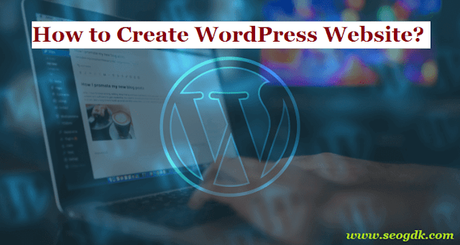
Is it necessary for your company to have an online presence? Then one of the first things you will do is create a business website. It is one of the simplest and most cost-effective methods for locating clients both locally and globally. Honestly speaking, WordPress development is now pretty much everyone's go-to tool for creating and maintaining new websites. WordPress today runs an exceptionally varied variety of sites, from personal blogs to some of the largest online organizations. It has a reputation as one of the most capable content management systems ever devised.
But are you worried about doing it yourself? There is no need to worry as we got a complete guide. We'll show you how to use this potent tool to build a professional small-business website step by step from start to end.
Steps to Create a Small Business Website on WordPress
There are some simple steps to follow to make your business website described below:
1. Create a Domain Name and Get Your Hosting
A domain name is the 'name' of your website at which users can access it, such as www.mycompany.com. There are many different top-level domains to choose from. These can be country-specific, with suffixes like .com, .uk, .ie, or they might identify the sort of organization, such as.biz,.org. Many domains also offer to choose an email address that includes your website address, such as [email protected].
- Domain Registration
A domain name can be purchased via a domain name registrar. There are several registrars to choose from. Each one has its own set of qualities as well as pros and downsides. You can pay to register your domain name for a defined duration, ranging from a year to the maximum available from that particular registrar, once you've found one that fits your organization.
Many domain name registrars will also charge you extra for email addresses for your company.
- Hosting
Several businesses can sell you a hosting package. We will exemplify registering a domain with BlueHost, and even the domain is free with this hosting.
We’ll tell Bluehost to install and configure a fresh version of WordPress on our new hosting setup and walk away with a fully functional WordPress website!
You should receive an email from Bluehost shortly after completing the sign-up process with instructions on logging into your customer profile and working on your site.
- Setup Wizard
Once logged in, Bluehost will take you to an easy-to-follow wizard for the process of installing WordPress on your hosting configuration.
You may also install WordPress by heading to the My Sites section and selecting the Create Site option. BlueHost only needs the name of your new site and the username/password you want to use to manage WordPress to install WordPress for you. Your site will be installed and ready to use once you've completed the wizard.
2. Pick a Free Design
You can also look for a niche-specific theme. For example, there are several WordPress themes created just for salons. Such themes are recommended since they are professionally prepared.
There are themes to suit your every need. For example, themes for a bakery, a restaurant, a lawyer, a carpenter, an architect, a freelancer, a physician, a politician, a music club, a hotel, a pet store, and more!
3. Install Plugins and Do the Edits
Along with your theme, you need to select a plugin that will assist you in creating some of the key features that a business website would require, such as custom fields, posts, and a search. The toolset is one of the best plugins available, allowing you to create these features without code in PHP. Toolset offers a custom types training course that will show you how to make everything you'll need.
- Install Sample Data
It is not required that you install sample data with the theme, but we strongly recommend you do so because you'll have your site a little more organized with sample data. Additionally, with the widgets in their proper locations, your site will begin to appear more structured.
- Upload Logo and Add Site Title
Now, let us move on to the branding section of your company's website? Do you already have a logo? If not, you can create one or choose a theme that can easily edit the logo. Some themes like iBusiness allow you to edit the logo instantaneously just with a single click. You can also change the slogan at any time and replace it with your own. This is how it goes.
If you're using another WordPress theme, you'll find these options under Appearance >> Customize. So, if you already have a logo made, just upload the image file.
- Change Background and Color
If you are not using a pre-designed theme but using WordPress, you may definitely customize the appearance of your website.
The ability to change the theme color may be found in the upper right corner. You can do it with the backend options. The color options are grouped for your convenience and to maintain the symmetry of colors on your site.
- Arrange Page Elements
And now for the most crucial stage of all. Do you have an imaginary website in the back of your head when you decide to make your own website? Now is the time to concentrate on the look and feel of your website. What sections do you want where, and what elements do you want on your homepage, sidebars, and footer?
Using the widgets, this is fairly simple to accomplish. You may quickly reconstruct your website by rearranging the widgets.
Remove the recent comments widget from the homepage if you don't want it there. Select the widget and drag it into the required widget to display a calendar in the sidebar.
4. Add the Content
Now that the designing and customization elements have been completed, it's time to remove the example data provided by your theme and replace it with valuable and fresh content/pages.
- Create Pages with Easy Navigation
It is critical to arrange your website pages and build the navigation thoughtfully. You may construct intuitive menus with links to all of the main pages for navigation. Your visitors will navigate your site with ease if it has smooth navigation and links organized logically. So let's start with the most common and significant sections for your company's website. Let's take a look at the list of pages that are essential for your company's website.
However, it is entirely up to you what you want to include in your website's menu. However, make sure it contains connections to the pages that are most important to your website. You may even use it to determine the order of the menu items.
- Design Home Page
A superb homepage has both outstanding design and amazing content. The homepage should essentially contain all of your company's critical information.
You get a thoughtfully designed homepage when you use a premium theme. However, you can customize it as much as you want using the editing options. When designing your homepage, you must use extreme caution. The homepage of your website should ideally reflect both the core of your company and the content of your website. It is the page where the majority of your visitors will begin their visit.
You can, however, experiment with other architectures and arrangements for your homepage at any moment.
- Service Page
This might be a single page or a collection of pages stating "what you do." Service pages can explain the type of services offered, pricing for those services, or completed work.
Similarly, you can design about us, contact us, and blog section.
5. Promote and Maintain Your Website
Simply write your website's address on your visiting card to advertise your website and inform your existing clients about you. Create a Facebook page for yourself and discover how quickly it may grow in popularity! You can also earn money by showing adverts for your associated businesses. Simultaneously, you might approach relevant businesses to promote your company.
- Maintaining
It's usually a good idea to maintain your website and keep it up to date. You can also create new blogs, delete unnecessary pages, and update current ones as needed.
Keep up with the most recent information.
Responding to messages from contacts.
Keep an eye on your SEO optimization and speed tests.
Lastly…
There is no other option than to develop a business website as part of your efforts to improve your company. It's all about taking chances in business. So why don't you give it a shot when this guide is here to assist you all the time!!


